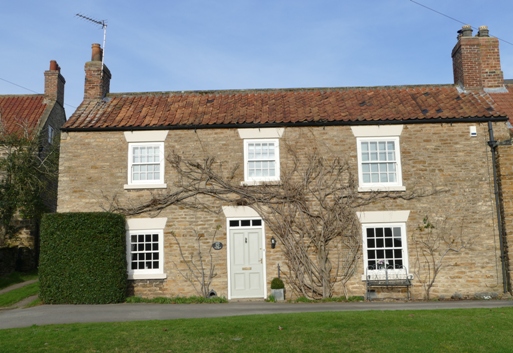Pubs
From at least the 1820s, there were 3 pubs in the village, the Black Bull, the Cross Keys and the Horse and Jockey (which became the Bay Horse before 1840). In the 1870s the Black Bull closed, to be replaced eventually by the school and schoolmaster's house, and in 1880s the Cross Keys closed and became a temperance hotel and reading room.
On this page you will find information about:
Bay Horse (former Horse and Jockey)

In the 1823 Baines Directory, Uriah Agar was victualler at the Horse and Jockey.
From 1840 or before (by which time it was the Bay Horse) to 1893 or later the Hawkins family were the innkeepers, first William and Elizabeth Hawkins and then, from 1872 their son James and his wife Alice. In 1901 James and Alice were still in Terrington but no longer at the pub and James was described as a farmer and carter.
After the Hawkins family there was a succession of innkeepers: John Cooper in 1901, Benjamin Bradley in 1905, Jesse Moor in 1909, Sam and Rose Atha in 1911, Arthur Bennett in 1913, Josiah Giles in 1921 and 1925, Edwin Nattress in 1929.
Susan Harrison was there in 1933 and features in a James Wimbush photo. The photo of a group assembled for a pantomine trip in 1947 also shows Susan Harrison on the inn sign and the building as it was before being white-washed. The door and bay window to the left of the pub, later taken over by the pub, belong to the tailor Wiliam Leaf.
The Bay Horse closed in 2011.


Black Bull
This was on the site where Terrington C. of E. School on North Back Lane and School House on Main Street now stand. It is shown on the 1856 Ordance Survey map.


In the 1823 Baines Directory, William Cordeux was victualler of the Black Bull. In 1840, Mary Cordeux was there, and in 1851 John and Elizabeth Harsley, who were still there in 1861. In 1871 the innkeeper was Abraham Wood.
On 18 July 1875, Samuel Wimbush reported that The Bull was sold, the public house for £500 and 6 acres of land for £660 to Mr M Worsley (who was living at Cliff Hall). The Worsleys donated the site of the Bull for building the new C. of E. school in 1890.
Cross Keys
This was on the site of the current Hope Cottage in Main Street, though it is not shown as a Public House on the 1856 Ordance Survey map.

Baines Directory of 1823 gives Richard Hick(s) as victualler at the Cross Keys, and Richard and his wife Hannah were still there in 1861. By 1871 Ellen Hicks (their daughter) was the innkeeper. Samuel Wimbush reported on 24 September 1874 that 'Miss Hicks, Cross Keys died today'.
In 1879, William Heath was at the Cross Keys and had a conveyance for hire. The 1881 census gave George Heath as innkeeper and farmer of 110 acres, and wife Mary, farmer's wife.
Then on 10 May 1884, Samuel Wimbush attended a meeting to arrange with Coatsworth as to his new duties as tenant of the Reading Room at The Cross Keys, 'now to be the Reading Room and not the Cross Keys'. Possibly it was a Castle Howard tenancy not renewed, and re-let by Mrs Rosalind Howard (she didn't become the Countess of Carlisle until 1889) as a reading room and temperance hotel with Samuel Wimbush’s support. She was an activist in the temperance movement and closed down all the public houses under Castle Howard control.
On 15 May the Heaths' sale took place and on 19 May they left the Cross Keys, allowing Coatsworth to take possession.
The temperance hotel was later run by Mrs Emma Hope whose sons ran a bus company (Hopes' Motor Services). The reading room continued to exist, in the upper floor, right-hand window. The cottage had two staircases, presumably one leading up to the reading room (personal communication, Mrs Hermione Foster, 2021).
